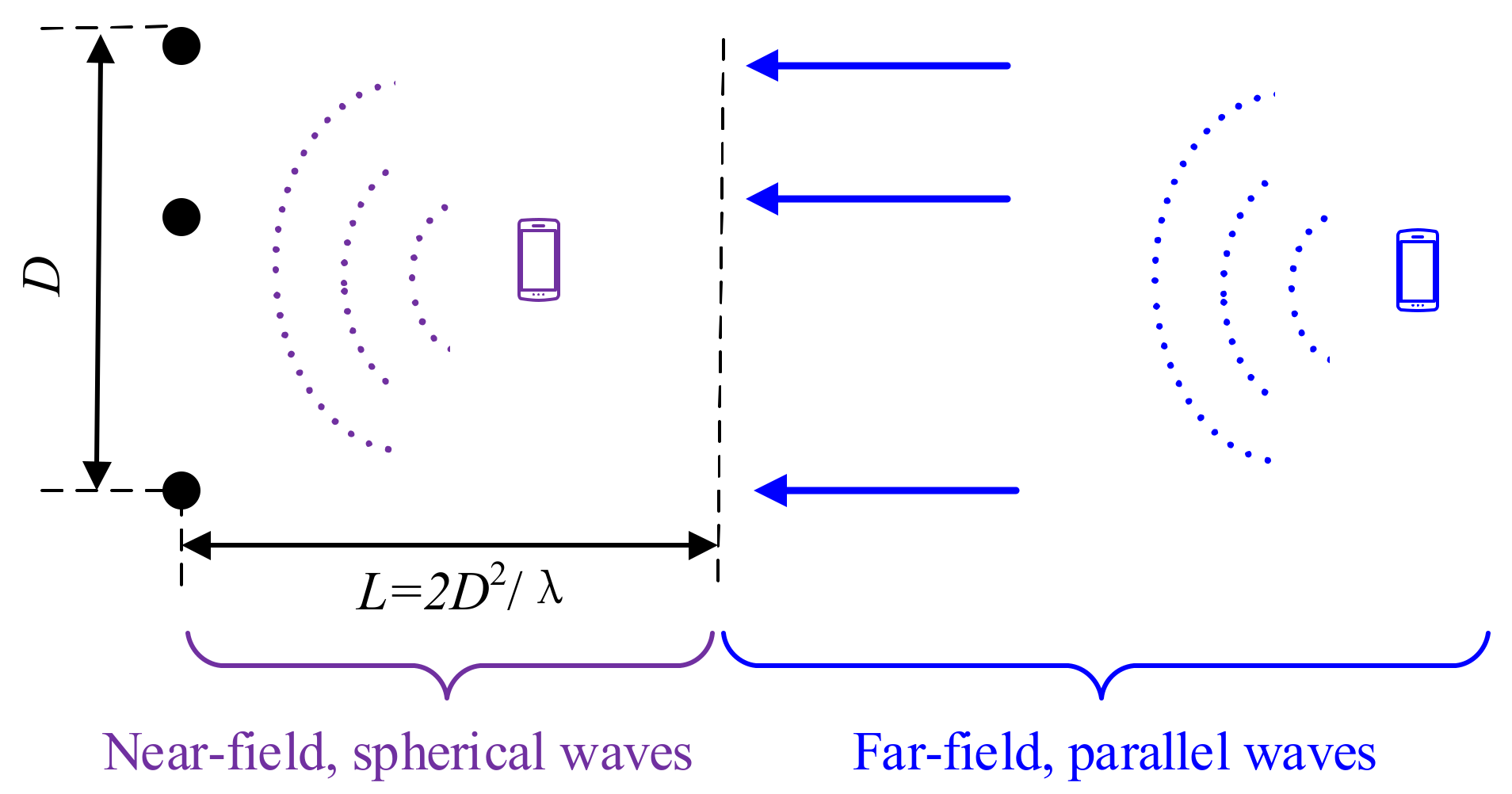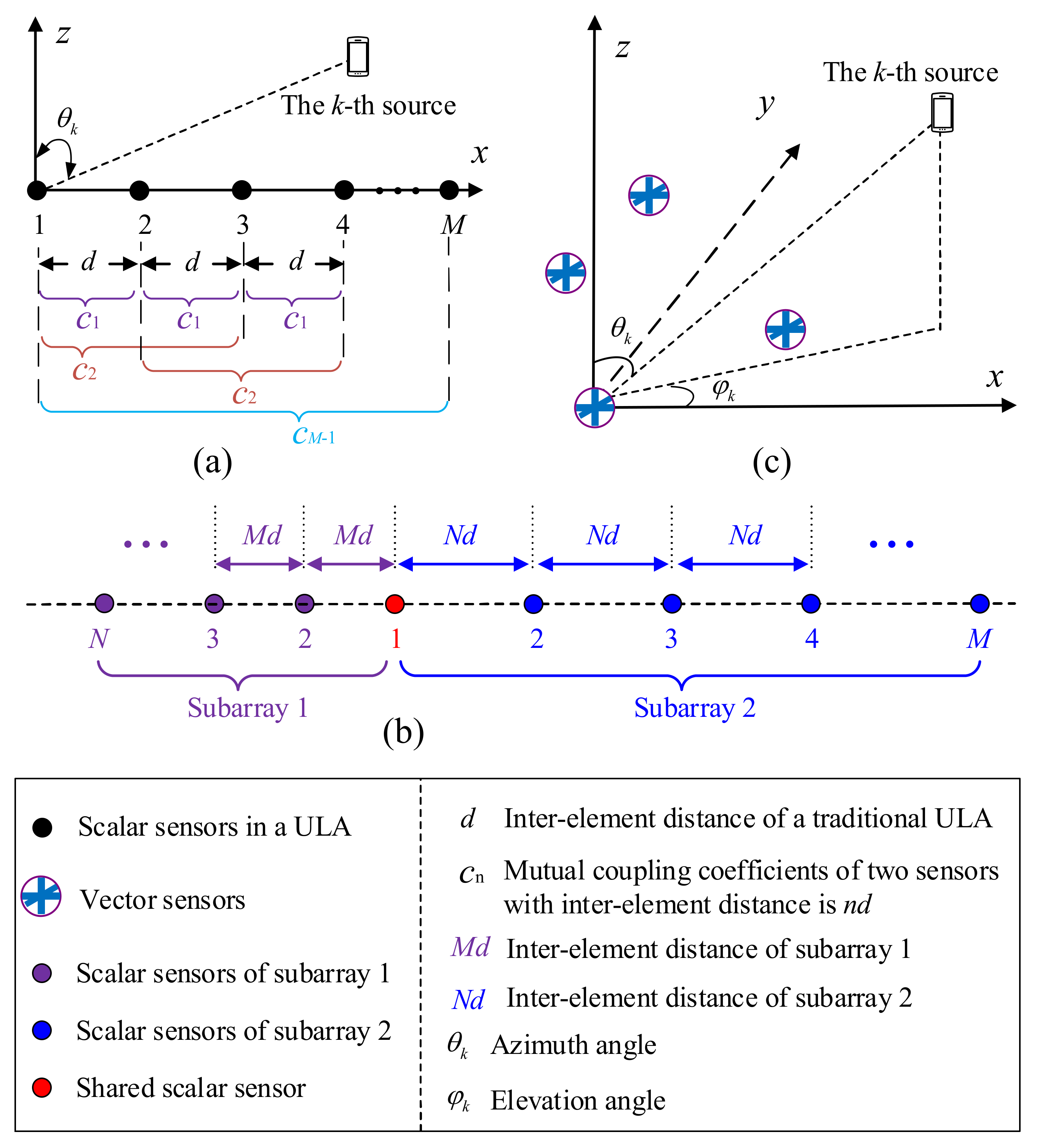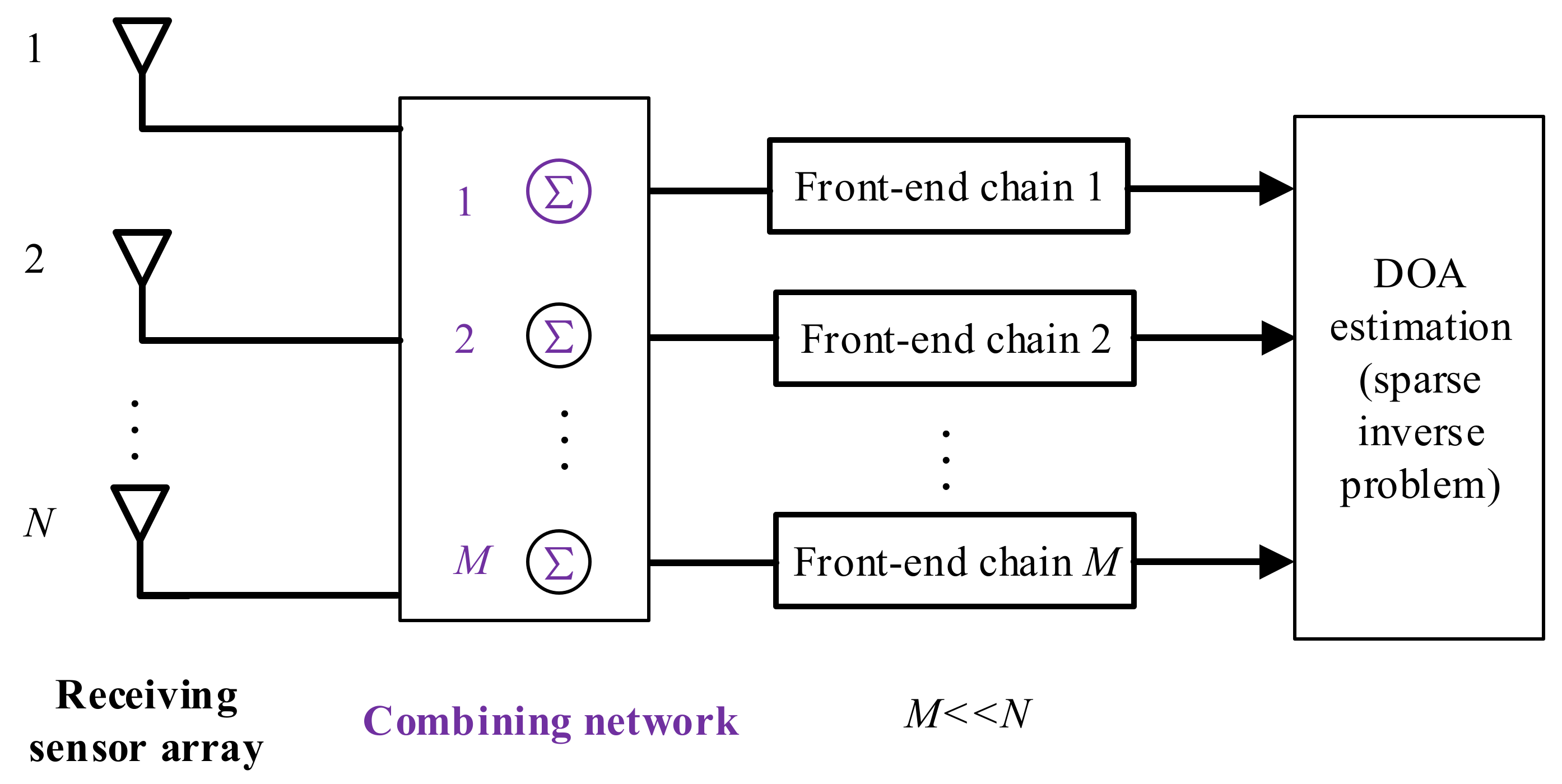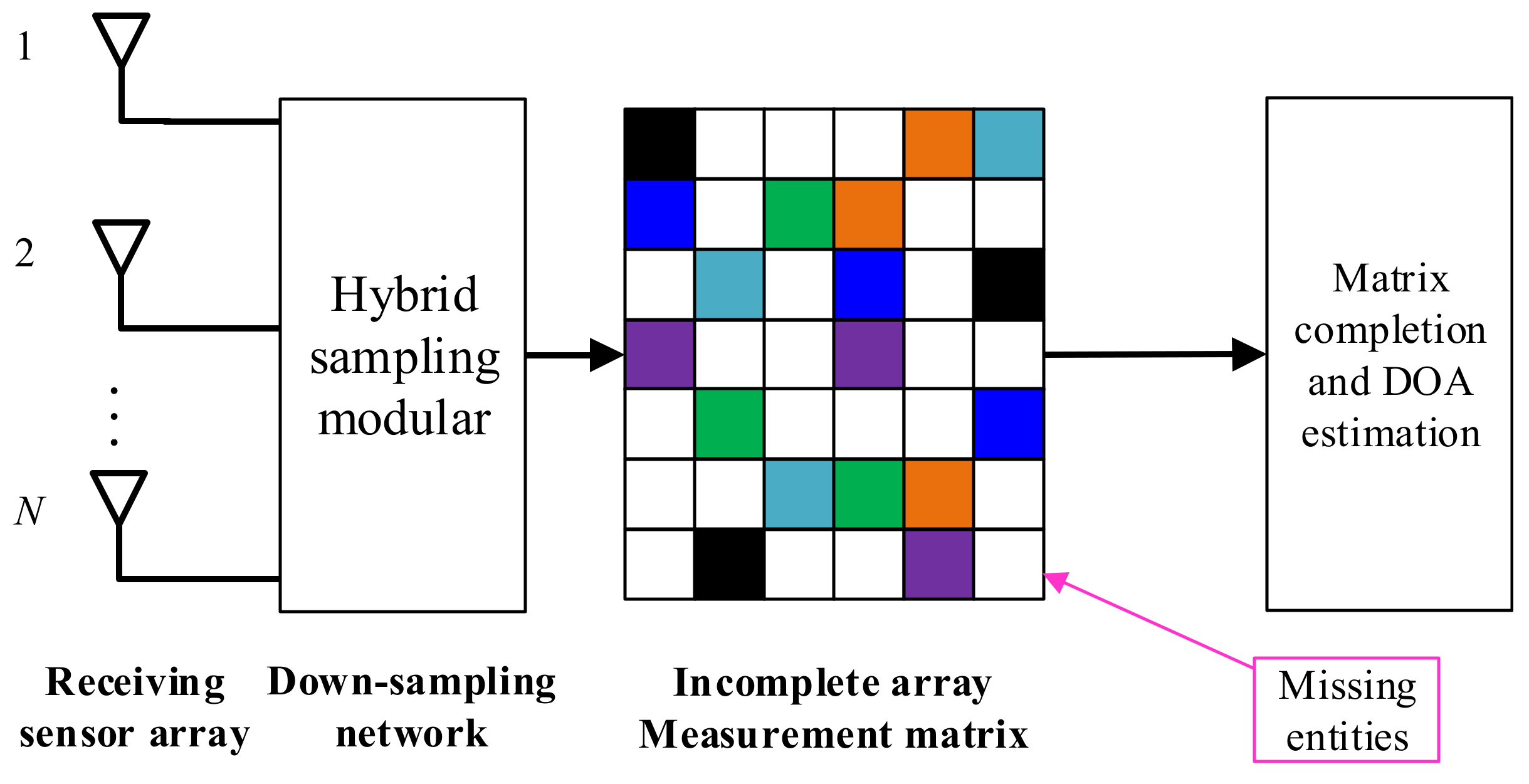DOA Estimation in B5G/6G: Trends and Challenges
Abstract
:1. Introduction
- (1)
- Data models representing DOA estimation with respect to hybrid-field sources, the mutual coupling effect, and sparse sampling frameworks have been introduced. The impacts of the corresponding model errors on DOA estimation have been analyzed.
- (2)
- The current advances in hybrid-field sources, the mutual coupling effect, and sparse sampling frameworks have been reviewed. Moreover, the limitations of state-of-the-art works have been summarized, and possible trends have been pointed out.
2. Signal Model of DOA Estimation
3. Far-Field, Near-Field, and Hybrid-Field
- (1)
- Accurate estimations of the number of sources with respect to far-field sources and near-field sources. Most of the current algorithms rely on prior knowledge of the source number. However, in the presence of hybrid-field sources, the existing algorithms can only estimate the total number of hybrid-field sources, while current algorithms require exact numbers with respect to far-field sources and near-field sources. An inaccurate source number would lead to model mismatching between the ideal model and the actual model and would yield decreased performance.
- (2)
- The near-field sources should be carefully separated from the far-field sources. After the source number has been determined, the near-field signals need to be separated from the far-field signals correctly; otherwise, the estimation algorithms may fail to work.
- (3)
- Super-resolution parameter estimation based on the exact model. Current DOA estimation algorithms for hybrid-field sources rely on the approximation of the Fresnel model, which has been proven to be unreasonable [34]. For accurate DOA estimation, extensive efforts need to be devoted to data modeling, array design, and estimation algorithms.
4. Sensor Mutual Coupling
- (1)
- For sparse array geometry, how to reduce the redundancy of sensors (or how to maximize the aperture with a given number of sensors) and how to unify (generalize) the array design requires sustained attention. Regardless of whether coprime arrays or nested arrays are used, two-level sparse arrays exhibit a common feature, i.e., the inter-element spacings of two subarrays are coprime. In other words, the important array parameters are fixed once the array type has been chosen. There is a need to develop more a general formulation for previous array parameters. Moreover, more efficient super-resolution algorithms for sparse array geometry is another topic that requires further research.
- (2)
- For the EMVS array, optimization is necessary for a less redundant EMVS [50]. As we pointed out in Equation (5), a single EMVS consists of six components, but only four unknown parameters are involved. Therefore, the EMVS array is redundant. The design of a less redundant EMVS and EMVS array are two interesting topics. Additionally, how to estimate high-resolution 2D-DOAs combined with the array geometry is also a topic of interest.
5. Spatial/Temporal Compressive Sampling
- (1)
- The implementation of low-complexity hardware for CS-based architectures for DOA estimation. With the advent of cloud platforms for B5G/6G wireless communications, the calculated overhead can be ignored, indicating that that are bright prospects for CS in the near future. However, CS-based frameworks can be further improved in terms of the total hardware costs (power, volume, electromagnetic compatibility, etc.), the overall system clock frequency, and the number of ADC channels/rates. In addition, how to make CS-based architectures compatible with the modular sampling in the communication system is also of interest.
- (2)
- Efficient DOA estimation algorithms based on sub-Nyquist measurements are of interest for future interest. Usually, optimization-based DOA estimators are inefficient. Since B5G/6G enforce strict latency constraints, how to achieve real-time DOA estimation is of interest. Moreover, how to overcome issues related to the low signal-to-noise ratio (SNR) and how to deal with the coherent source issue are also relevant.
6. Conclusions
Author Contributions
Funding
Institutional Review Board Statement
Informed Consent Statement
Data Availability Statement
Conflicts of Interest
References
- Kim, B.; Kim, S.; Lee, J. A novel DFT-based DOA estimation by a virtual array extension using simple multiplications for FMCW radar. Sensors 2018, 18, 1560. [Google Scholar] [CrossRef] [Green Version]
- Ahmed, A.U.; Arablouei, R.; De Hoog, F.; Kusy, B.; Jurdak, R.; Bergmann, N. Estimating angle-of-arrival and time-of-flight for multipath components using wifi channel state information. Sensors 2018, 18, 1753. [Google Scholar] [CrossRef] [Green Version]
- Hsu, K.C.; Kiang, J.F. Joint estimation of DOA and frequency of multiple sources with orthogonal coprime arrays. Sensors 2019, 19, 335. [Google Scholar] [CrossRef] [Green Version]
- Suksiri, B.; Fukumoto, M. An efficient framework for estimating the direction of multiple sound sources using higher-order generalized singular value decomposition. Sensors 2019, 19, 2977. [Google Scholar] [CrossRef] [Green Version]
- Lee, S.; Kim, S.C. Logarithmic-domain array interpolation for improved direction of arrival estimation in automotive radars. Sensors 2019, 19, 2410. [Google Scholar] [CrossRef] [Green Version]
- Saad, W.; Bennis, M.; Chen, M. A vision of 6G wireless systems: Applications, trends, technologies, and open research problems. IEEE Netw. 2020, 34, 134–142. [Google Scholar] [CrossRef] [Green Version]
- Wang, Y.; Gui, G.; Gacanin, H.; Ohtsuki, T.; Dobre, O.A.; Poor, H.V. An efficient specific emitter identification method based on complex-valued neural networks and network compression. IEEE J. Sel. Areas Commun. 2021, 39, 2305–2317. [Google Scholar] [CrossRef]
- Wu, K.; Ni, W.; Su, T.; Liu, R.P.; Guo, Y.J. Recent breakthroughs on angle-of-arrival estimation for millimeter-wave high-speed railway communication. IEEE Commun. Mag. 2019, 57, 57–63. [Google Scholar] [CrossRef]
- Shi, J.; Yang, Z.; Liu, Y. On parameter identifiability of diversity-smoothing-based MIMO radar. IEEE Trans. Aerosp. Electron. Syst. 2022; in press. [Google Scholar] [CrossRef]
- Wang, H.; Wan, L.; Dong, M.; Ota, K.; Wang, X. Assistant vehicle localization based on three collaborative base stations via SBL-based robust DOA estimation. IEEE Internet Things J. 2019, 6, 5766–5777. [Google Scholar] [CrossRef]
- Wen, F.; Wang, J.; Shi, J.; Gui, G. Auxiliary vehicle positioning based on robust DOA estimation with unknown mutual coupling. IEEE Internet Things J. 2020, 7, 5521–5532. [Google Scholar] [CrossRef]
- Wang, X.; Yang, L.T.; Meng, D.; Dong, M.; Ota, K.; Wang, H. Multi-UAV cooperative localization for marine targets based on weighted subspace fitting in SAGIN environment. IEEE Internet Things J. 2022, 9, 5708–5718. [Google Scholar] [CrossRef]
- Guo, Y.; Wang, X.; Lan, X.; Su, T. Traffic target location estimation based on tensor decomposition in intelligent transportation system. IEEE Tran. Intell. Transp. Syst. 2022, 1–3. [Google Scholar] [CrossRef]
- Cong, J.; Wang, X.; Yan, C.; Yang, L.T.; Dong, M.; Ota, K. CRB weighted source localization method based on deep neural networks in multi-UAV network. IEEE Internet Things J. 2022, 1. [Google Scholar] [CrossRef]
- Tian, Y.; Liu, S.; Liu, W.; Chen, H.; Dong, Z. Vehicle positioning with deep learning-based direction-of-arrival estimation of incoherently distributed sources. IEEE Internet Things J. 2022, 1. [Google Scholar] [CrossRef]
- Schmidt, R.; Schmidt, R.O. Multiple emitter location and signal parameter estimation. IEEE Trans. Antenn. Propag. 1986, 34, 276–280. [Google Scholar] [CrossRef] [Green Version]
- Roy, R.; Kailath, T. ESPRIT-estimation of signal parameters via rotational invariance techniques. IEEE Trans. Acoust. Speech Signal Processing 1989, 37, 984–995. [Google Scholar] [CrossRef] [Green Version]
- Rao, B.D.; Hari, V.S.K. Performance analysis of Root-MUSIC. IEEE Trans. Acoust. Speech Signal Processing 1989, 34, 276–280. [Google Scholar] [CrossRef]
- Lee, H.B.; Wengrovitz, M.S. Resolution threshold of beamspace MUSIC for two closely spaced emitters. IEEE Trans. Acoust. Speech Signal Processing 1990, 38, 1545–1559. [Google Scholar] [CrossRef]
- Kundu, D. Modified MUSIC algorithm for estimating DOA of signals. Signal Process. 1996, 48, 85–90. [Google Scholar] [CrossRef]
- Palanisamy, P.; Rao, N. Direction of arrival estimation based on fourth-order cumulant using propagator method. IEEE Int. Conf. Signal Image Process 2009, 18, 83–99. [Google Scholar] [CrossRef] [Green Version]
- Koh, J.; Lim, D.; Sarkar, T.K. DOA estimation using matrix pencil method. IEICE Trans. Commun. 2004, 87, 1427–1429. [Google Scholar]
- Stoica, P.; Nehorai, A. MUSIC, maximum likelihood, and Cramér-Rao bound: Further results and comparisons. IEEE Trans. Acoust. Speech Signal Processing 1990, 38, 2140–2150. [Google Scholar] [CrossRef]
- Yang, Z.; Xie, L.; Zhang, C. Off-grid direction of arrival estimation using sparse bayesian inference. IEEE Trans. Signal Process. 2013, 61, 38–43. [Google Scholar] [CrossRef] [Green Version]
- Cui, M.; Dai, L. Channel estimation for extremely large-scale MIMO: Far-field or near-field? IEEE Trans. Commun, 2022; in press. [Google Scholar] [CrossRef]
- Adachi, Y.; Iiguni, Y.; Maeda, H. Second-order approximation for DOA estimation of near-field sources. Circ. Syst. Signal Process. 2003, 22, 287–306. [Google Scholar] [CrossRef]
- He, J.; Li, L.; Shu, T. Localization of near-field sources for exact source-sensor spatial geometry. IEEE Signal Process. Lett. 2020, 27, 1040–1044. [Google Scholar] [CrossRef]
- He, J.; Swamy, M.N.S.; Ahmad, M.O. Efficient application of MUSIC algorithm under the coexistence of far-field and near-field sources. IEEE Trans. Signal Process. 2012, 60, 2066–2070. [Google Scholar] [CrossRef]
- He, J.; Shu, T.; Li, L.; Truong, T.-K. Mixed near-field and far-field localization and array calibration with partly calibrated arrays. IEEE Trans. Signal Process. 2022, 70, 2105–2118. [Google Scholar]
- Shu, T.; He, J.; Dakulagi, V. 3-D near-field source localization using a spatially spread acoustic vector sensor. IEEE Trans. Aerosp. Electron. Syst. 2022, 58, 180–188. [Google Scholar] [CrossRef]
- Wen, F.; Shi, J.; Zhang, Z. Generalized spatial smoothing in bistatic EMVS-MIMO radar. Signal Process. 2022, 193, 108406. [Google Scholar] [CrossRef]
- Zheng, G.; Song, Y.; Chen, C. Height measurement with meter wave polarimetric MIMO radar: Signal model and MUSIC-like algorithm. Signal Process. 2022, 190, 108344. [Google Scholar] [CrossRef]
- He, J.; Li, L.; Shu, T.; Truong, T.-K. Mixed near-field and far-field source localization based on exact spatial propagation geometry. IEEE Trans. Veh. Technol. 2021, 70, 3540–3551. [Google Scholar] [CrossRef]
- Friedlander, B. Localization of signals in the near-field of an antenna array. IEEE Trans. Signal Process. 2019, 67, 3885–3893. [Google Scholar] [CrossRef]
- Hu, W.; Wang, Q. DOA estimation for UCA in the presence of mutual coupling via error model equivalence. IEEE Wirel. Commun. Lett. 2020, 9, 121–124. [Google Scholar] [CrossRef]
- Elbir, A.M. A novel data transformation approach for DOA estimation with 3-D antenna arrays in the presence of mutual coupling. IEEE Antennas Wirel. Propag. Lett. 2017, 16, 2118–2121. [Google Scholar] [CrossRef]
- Elbir, A.M. Direction finding in the presence of direction-dependent mutual coupling. IEEE Antennas Wirel. Propag. Lett. 2017, 16, 1541–1544. [Google Scholar] [CrossRef]
- Wu, J.; Wen, F.; Shi, J. Direction finding in bistatic MIMO radar with direction-dependent mutual coupling. IEEE Commun. Lett. 2021, 25, 2231–2234. [Google Scholar] [CrossRef]
- Wu, J.; Wen, F.; Shi, J. Fast angle estimation in MIMO system with direction-dependent mutual coupling. IEEE Commun. Lett. 2021, 25, 2913–2917. [Google Scholar] [CrossRef]
- Li, B.; Liu, C.; Wu, H. A moment-based study on the impedance effect of mutual coupling for vlf umbrella antenna arrays. Prog. Electrom. Res. C 2017, 76, 75–86. [Google Scholar] [CrossRef] [Green Version]
- Kim, Y.-D.; Yi, D.-W.; Yang, S.-J.; Chae, H.; Yu, J.-W.; Myung, N.-H. Beam pattern analysis of antenna array on complex platform using AEP method based on hybrid UTD-ACGF technique. IEEE Trans. Antenn. Propag. 2017, 65, 1511–1516. [Google Scholar] [CrossRef]
- Casati, D.; Hiptmair, R.; Smajic, J. Coupling finite elements and auxiliary sources for electromagnetic wave propagation. Int. J. Num. Model. Elect. Net. 2020, 33, 2752. [Google Scholar] [CrossRef]
- Chen, P.; Cao, Z.; Chen, Z.; Yu, C. Sparse off-grid DOA estimation method with unknown mutual coupling effect. Digit. Signal Process. 2019, 90, 1–9. [Google Scholar] [CrossRef]
- Chen, P.; Cao, Z.; Chen, Z.; Wang, X. Off-grid DOA estimation using sparse Bayesian learning in MIMO radar with unknown mutual coupling. IEEE Trans. Signal Process. 2019, 67, 208–220. [Google Scholar] [CrossRef] [Green Version]
- Zheng, Z.; Yang, C.; Wang, W.-Q.; So, H.C. Robust DOA estimation against mutual coupling with nested array. IEEE Signal Process Lett. 2020, 27, 1360–1364. [Google Scholar] [CrossRef]
- Basikolo, T.; Ichige, K.; Arai, H. A novel mutual coupling compensation method for underdetermined direction of arrival estimation in nested sparse circular arrays. IEEE Trans. Antenn. Propag. 2018, 66, 909–917. [Google Scholar] [CrossRef]
- Zeng, H.R.; He, T.; Li, K. Mutual coupling effect on arbitrarily oriented VLF circular antenna array in ionospheric plasma. IEEE Trans. Antenn. Propag. 2021, 69, 7551–7561. [Google Scholar] [CrossRef]
- Vaidyanathan, P.P.; Pal, P. Sparse sensing with co-prime samplers and arrays. IEEE Trans. Signal Process. 2011, 59, 573–586. [Google Scholar] [CrossRef]
- Ren, M.J.; Hu, G.; Shi, J.; Zhou, H. Generalized and symmetric coprime planar array for direction of arrival estimation. IET Radar Sonar Nav. 2022, 16, 961–969. [Google Scholar] [CrossRef]
- He, J.; Li, L.; Shu, T. Sparse nested arrays with spatially spread orthogonal dipoles: High accuracy passive direction finding with less mutual coupling. IEEE Trans. Aeros. Elec. Sys. 2021, 57, 2337–2345. [Google Scholar] [CrossRef]
- Candes, E.; Tao, T. Decoding by linear programming. IEEE Trans. Inform. Theory 2005, 51, 4203–4215. [Google Scholar] [CrossRef] [Green Version]
- Rossi, M.; Haimovich, A.M.; Eldar, Y.C. Spatial compressive sensing for MIMO radar. IEEE Trans. Signal Process. 2013, 62, 419–430. [Google Scholar] [CrossRef] [Green Version]
- Gu, Y.; Goodman, N.A. Information-theoretic compressive sensing kernel optimization and Bayesian Cramer-Rao bound for time delay estimation. IEEE Trans. Signal Process. 2017, 65, 4525–4537. [Google Scholar] [CrossRef]
- Guo, M.; Zhang, Y.D.; Chen, T. DOA estimation using compressed sparse array. IEEE Trans. Signal Process. 2018, 66, 4133–4146. [Google Scholar] [CrossRef]
- Koochakzadeh, A.; Pal, P. Compressed arrays and hybrid channel sensing: A Cramér-Rao bound based analysis. IEEE Signal Process. Lett. 2020, 27, 1395–1399. [Google Scholar] [CrossRef]
- Du, J.; Xu, W.; Shen, H.; Dong, X.; Zhao, C. Department of Electrical and Computer Engineering, University of Victoria, Victoria, BC, CanadaHybrid precoding architecture for massive multiuser MIMO with dissipation: Sub-connected or fully connected structures? IEEE Trans. Wirel. Commun. 2018, 17, 5465–5479. [Google Scholar] [CrossRef] [Green Version]
- Nguyen, N.T.; Lee, K. Unequally sub-connected architecture for hybrid beamforming in massive MIMO systems. IEEE Trans. Wirel. Commun. 2020, 19, 1127–1140. [Google Scholar] [CrossRef] [Green Version]
- Wang, X.; Greco, M.S.; Gini, F. Adaptive sparse array beamformer design by regularized complementary antenna switching. IEEE Trans. Signal Process. 2021, 69, 2302–2315. [Google Scholar]
- Zhang, R.; Shim, B.; Wu, W. Direction-of-arrival estimation for large antenna arrays with hybrid analog and digital architectures. IEEE Trans. Signal Process. 2022, 70, 72–88. [Google Scholar] [CrossRef]
- Huang, X.; Liao, B. One-bit MUSIC. IEEE Signal Process. Lett. 2019, 26, 961–965. [Google Scholar] [CrossRef] [Green Version]
- Sheng, S.; Chen, P.; Yao, Y.; Wu, L.; Chen, Z. Atomic network-based DOA estimation using low-bit ADC. Electronics 2021, 10, 738. [Google Scholar] [CrossRef]
- Shi, B.; Chen, N.; Zhu, X.; Qian, Y.; Zhang, Y.; Shu, F.; Wang, J. Impact of low-resolution ADC on DOA estimation performance for massive MIMO receive array. IEEE Syst. J. 2022, 16, 2635–2638. [Google Scholar] [CrossRef]
- Shi, B.; Zhu, L.; Cai, W.; Chen, N.; Shen, T.; Zhu, P.; Shu, F.; Wang, J. On performance loss of DOA measurement using massive MIMO receiver with mixed-ADCs. IEEE Wirel. Commun. Lett. 2022, 1. [Google Scholar] [CrossRef]
- Sun, S.; Bajwa, W.U.; Petropulu, A.P. MIMO-MC radar: A MIMO radar approach based on matrix completion. IEEE Trans. Aeros. Elec. Sys. 2015, 51, 1839–1852. [Google Scholar] [CrossRef] [Green Version]
- Liu, Q.; Li, X.; Cao, H. Two-dimensional localization: Low-rank matrix completion with random sampling in massive MIMO system. IEEE Syst. J. 2021, 15, 3628–3631. [Google Scholar] [CrossRef]
- Sedighi, S.; Mysore, B.S.; Soltanalian, M.; Ottersten, B. On the performance of one-bit DOA estimation via sparse linear arrays. IEEE Trans. Signal Process. 2021, 69, 6165–6182. [Google Scholar] [CrossRef]







| Method | Advantages | Disadvantages |
|---|---|---|
| MUSIC | Suitable for arbitrary geometry | Computationally inefficient, off-grid issues (can be avoided by root-MUSIC) |
| ESPRIT | Closed-form solution | Only suitable for uniform array geometry |
| PM | Computationally economic | Sensitive to small snapshots |
| Matrix pencil | Suitable for single snapshot | Sensitive to noise power |
| Sparse algorithms | Super-resolution, insensitive to prior knowledge of source number | Computationally inefficient, off-grid issues |
| Array Type | Advantages | Disadvantages |
|---|---|---|
| Scalar array | Low redundancy and low complexity | Strict sensor position, low identifiability |
| EMVS array | Closed-form solution, capable of 2D-DOA estimation with 1D geometry, suitable for arbitrary geometry, robust to sensor position error, better identifiability | High redundancy and high complexity |
Publisher’s Note: MDPI stays neutral with regard to jurisdictional claims in published maps and institutional affiliations. |
© 2022 by the authors. Licensee MDPI, Basel, Switzerland. This article is an open access article distributed under the terms and conditions of the Creative Commons Attribution (CC BY) license (https://creativecommons.org/licenses/by/4.0/).
Share and Cite
Ruan, N.; Wang, H.; Wen, F.; Shi, J. DOA Estimation in B5G/6G: Trends and Challenges. Sensors 2022, 22, 5125. https://doi.org/10.3390/s22145125
Ruan N, Wang H, Wen F, Shi J. DOA Estimation in B5G/6G: Trends and Challenges. Sensors. 2022; 22(14):5125. https://doi.org/10.3390/s22145125
Chicago/Turabian StyleRuan, Ningjun, Han Wang, Fangqing Wen, and Junpeng Shi. 2022. "DOA Estimation in B5G/6G: Trends and Challenges" Sensors 22, no. 14: 5125. https://doi.org/10.3390/s22145125
APA StyleRuan, N., Wang, H., Wen, F., & Shi, J. (2022). DOA Estimation in B5G/6G: Trends and Challenges. Sensors, 22(14), 5125. https://doi.org/10.3390/s22145125






